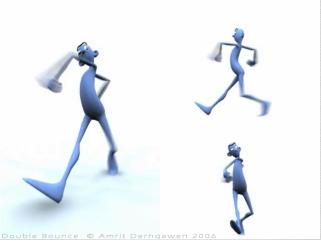Few days back I was working on "Character Ball" and stuff... I decided to give it a form of a tutorial for other new folks who feel confused about all this stuff. I've also posted it on CGTantra to help someone in the forums.
This tutorial is just my way of approaching this kinda stuff. I'm learning a lot from Animator's Survival Kit,
Keith Lango's VTS besides several other sources. Over here I'm just putting them all together for others to better understand all these concepts. If you don't feel comfortable with it, thats perfectly okay. This is how I work, for almost all my scenes. And it may not be the best method for you...but yeah its helpful and has helped me a lot. So I hope you like it!!Some of my friends frequently ask me (who are comparatively new to animation), " Hey! what is the difference between a "character ball" and a normal bouncing ball??" Do they bounce differently?? Well, Yeah! They do bounce differently!! A normal bouncing ball...just BOUNCES....boink..boink..boink....boink...... And a character ball HOPS....blob...blob....blob....blob....just like a flour sack (used very commonly in 2D animations). Yeah, it can bounce too just like a normal bouncing ball, but that all depends on the mood of the ball So there is a big difference in the timing of these balls. A character ball has some life...and some internal force which drives it and makes it hop!
I recommend everyone to learn working in the stepped mode, and then treat every frame as a single drawing. Keith always tells us to treat a frame as a single drawing. Its very similar to 2D animation, where you draw each and every frame. That really makes sense. Just forget the graph editor. You'll come back to it when you'll add the interpolation. Remember that Maya or any other CG software is just a pencil, a high tech pencil. In these CG software you don't have to draw with hand, you just have to play with the controls to change the shapes. Rest stays just the same as in 2d animation. Actually what we call a 3d animation is a 2d animation, but with better color and calculated mathematical shades.... so it appears to have some realistic depth. But on a screen, its another 2d animation which is flat. So there is not much of a difference other than the realistic looking shades.
In the old days, lead animators did all the key drawings and the major breakdowns, and their assistant would add the inbetweens intelligently. But over here, we don't have a human assitant or inbetweener to help us. But, we have our CG software.....Maya, Max or XSI... They are your dumb assistant! Actually we should blame the computer. They just know how to put some straight inbetweens and sometimes they make things look crap. So, what we need to do here, in CG, is to create a boundry line for the computer and we tell the computer not to go beyond that boundary. Because you know, that going any further will make your animation look really ugly. So you create these boundaries. What are these boundaries?? Yes, they are your "Key Drawings" and the "Breakdowns", which stop the computer at that boundary line. And your animation looks crisp and tight with your timing and stuff. So yes, if you're using Maya....then Maya is your "inbetweener friend", but believe me he is really DUMB!! He doesn't know what he is doing. He does his job and puts staight inbetweens anywhere you let him. So don't let the computer take over, because it'll make everything look ugly. Keep everything under control, and the computer will do wonders for you!! When you're done with the keys and the breakdowns, only then let the computer decide the inbetweens to make things smoother. In Keith's words, its just like adding some "Icing on a cake"!!
Okay, here's one bouncing ball (blocked/timed...no interpolation) I made it for my tutorial.
MonkeyJam however I'm not too happy with the timing. I should've given some more time on it. But its okay for a tutorial and serves the purpose.For spacing, some people use motion trail and ghosting feature. But I hate doing that. Its not that fast. I just take my "Dry Erase Marker" or "Erasable Marker", and mark or draw on my computer monitor. You can just make a dot at the center of the ball or do whatever you want. Its really good for checking the spacings and the arc of the motion. Don't do that on your laptop or LCD monitor though, it'll affect your screen.
Alrighty, I hope you find this tutorial helpful!
Thanks a lot!



